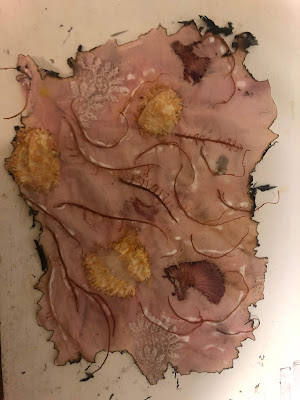En Esta Piel Viva Mi Cuerpo Anhela
...in this living skin
my body yearns...
En Esta Piel Viva Mi Cuerpo Anhela
 | ||
“Death would happen cell by cell, receptor by receptor; each of life’s minute sensations would be torched. Today people who have somehow survived accidental burning come to the burn units of Metropolitan hospitals to be redressed. If their burns are too deep for the body to repair by itself, they receive temporary coverings (cadaver skin, pigskin, lubricated gauze) until doctors can begin grafting skin from other body parts. Our skin makes up about 16% of our body weight (about 6 pounds), and stretches two square yards, but if too much of the body is burned there isn't enough skin graft. . . . covered the boys with cadaver skin and artificial membrane, removed small squares of skin from their armpits and cultured them into large sheets of skin, which they grafted on gradually over a five month period.”- Excerpt from Diane Ackerman's Natural History of Senses [section]: The Feeling Bubble
This piece is made from naturally dyed cotton using onion and red cabbage skins to further emphasize the use of alternative membranes in the body's healing process. The edges of the fabric were then burned, expressing the death and decomposition of the skin, and with it the loss of sensation. The thin, inner layers of the maracuyá fruit as well as onion were peeled, soaked and sewn into the dyed cotton. Their fragility and thin state represent the meticulous nature of the process of renewal. Deep crimson veins, made of tamarind pods, circulate the newly incorporated skin, bringing circulation and existence to this foreign skin. The white ink and glue around the veins act act as a stand in for white blood cells - our bodies natural disease fighters, fully encompassing this understanding of life after death and the body's resilience.
Pulso isotópico
...Isotopic Pulse...
“We remember the feel of the loved ones hand, how is body curves, the texture of his hair. touch allows us to find our way in the world in the darkness or in other circumstances where we can't fully use our other senses.” - Excerpt from Diane Ackerman's Natural History of Senses [section]: The Skin Has Eyes
“The launch itself produced an electromagnetic upset much like that of an earthquake and increased the static electricity in the air, which made my flesh creep. even those Skeptics Among Us viewers could not have been left unmoved, what would the hair standing up on their next, the shock waves pounding on their chest like giant cysts, their minds alert from the stimulating dance of negative ions, and the distance spacecraft lurching upward on spasms of apricot fire.” - Excerpt from Diane Ackerman's Natural History of Senses [section]: Animals
This piece was inspired by two particular sections within Ackerman's Touch section of her profound publication, Natural History of Senses. I was immediately reminded of the attraction and repulsion of atoms in the chemical realm upon reading each of the passages above. The hands are made from ink dyed paper divided apart by thin pins to create this notion of blank space.
Touch plays a fundamental role in how we perceive and interact with the world around us.
Everything we see, touch, and “feel” is made up of incredibly teeny-weeny fragments of matter known as atoms. Within those atoms, the number of electrons present indicate whether it will be positively or negatively charged and those very particles are naturally attracted to particles with an opposite charge, and they repel other similarly charged particles. Meaning that the electrons never actually come into contact with one another. This indicates that we ourselves never "actually" come into direct contact with anything. There is always a super small area of blank space. So it begs the question in a species that is driven by touch, and electron repulsion prevents us from actually touching anything, then "Why do we perceive and feel touch as real?”





Comments
Post a Comment